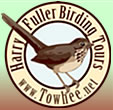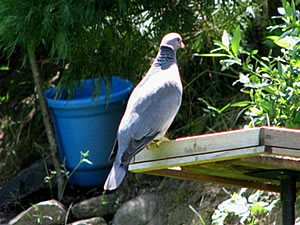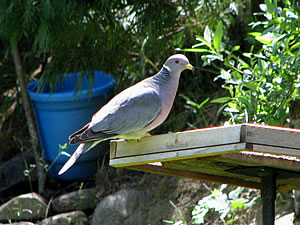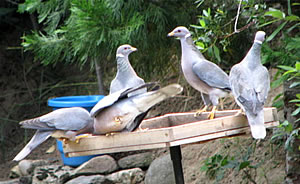





SOUTH-WESTERN OREGON

Band-tailed Pigeon
June, 2008, Ashland Oregon:
 "BeeTee" is the moniker I bestowed on the Band-tailed Pigeon now appearing regularly in our yard every afternoon. About 2 pm. Here're two pics, taken from our porch. BeeTee is very cool about being a model. He/she just assumes a composed demeanor and doesn't demean her/himself with fidgeting or jumping about. And there seems to be a preferred perch, on the east end of the feeding platform facing west.
"BeeTee" is the moniker I bestowed on the Band-tailed Pigeon now appearing regularly in our yard every afternoon. About 2 pm. Here're two pics, taken from our porch. BeeTee is very cool about being a model. He/she just assumes a composed demeanor and doesn't demean her/himself with fidgeting or jumping about. And there seems to be a preferred perch, on the east end of the feeding platform facing west.
This fine western American forest bird was first discovered for science by Thomas Say. He was naturalist on the Long Expedition to the Rockies in 1819-20. Say wrote the first description of this species, naming it Columba fasciata. The expedition was camped near Castle Rock, Colorado, when Say shot this bird.
According to BNA our coastal pigeon subspecies is darker and larger than the interior subspecies found in the southwestern deserts with a range that extends down into Central America. Altogether the Band-tailed Pigeon's eight subspecies are spread from Alaska south to South America, though never along the Atlantic Coast.
 The BT Pigeon is still hunted in six states of the US, Mexico and countries south of there. Oregon and California allow some hunting still. Washington and Nevada do not. The bird has protection in Canada. The population trend in the US is negative according to BNA. Though the bird does adapt to farms and towns (and my garden), they continue to diminish in numbers. Little is known about what is causing the decline in BT Pigeons. Here's the conclusion of BNA, essentially that we humans are just no paying attention.
The BT Pigeon is still hunted in six states of the US, Mexico and countries south of there. Oregon and California allow some hunting still. Washington and Nevada do not. The bird has protection in Canada. The population trend in the US is negative according to BNA. Though the bird does adapt to farms and towns (and my garden), they continue to diminish in numbers. Little is known about what is causing the decline in BT Pigeons. Here's the conclusion of BNA, essentially that we humans are just no paying attention.
"Lack of management efforts stem from inadequate funding at state and regionwide levels. Management plans exist (coastal) or are being developed (U.S. interior); not a high priority, and activist groups have not championed the species. If sufficient and consistent funding is provided, research and management programs can proceed..."
 Group of Band-tailed Pigeons in our garden, Ashland. Photo: Harry Fuller
Group of Band-tailed Pigeons in our garden, Ashland. Photo: Harry Fuller
So I 'm doing my little bit to keep at least one of these large pigeons well-fed. No hunting in my garden. They eat principally grain, seeds, fruit, acorns, pine nuts, and inflorescences of trees and shrubs. But apparently nobody's really studied them in detail, and they are still persecuted for stealing grain or fruit in some agricultural areas when they gather in large numbers. The BT feeds its young on regurgitated crop milk.
If they are like their cousin, the Passenger Pigeon, they may need a certain population density to thrive. Early reports on the BT indicated they were colonial nesters. There is no current evidence that this is true. Another little mystery about this large bird.
Studies found males tend the nest from mid-morning to mid-afternoon. Then the female takes over. That would indicate BeeTee is a she. She's arrived so far in early afternoon. Apparently she has not or cannot communicate about our feeder with her mate.
Here in Oregon the BT Pigeon is found only along the damp coastal third of the state, mostly in the Coastal Range though some are found in the western foothills of the Cascades. Primarily they nest in Douglas-fir here in Oregon. That means from elevations of 3000 on up. They're migratory in this part of their range, leaving in October, returning in March.
TOWHEE.NET: Harry Fuller, 820 NW 19th Street, McMinnville, OR 97128
website@towhee.net